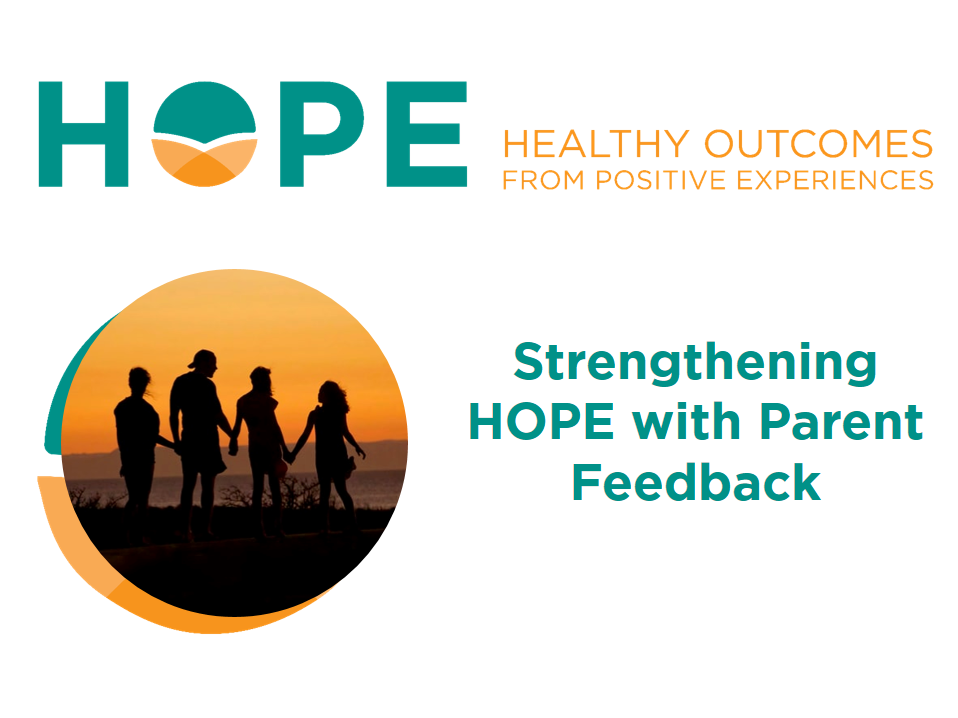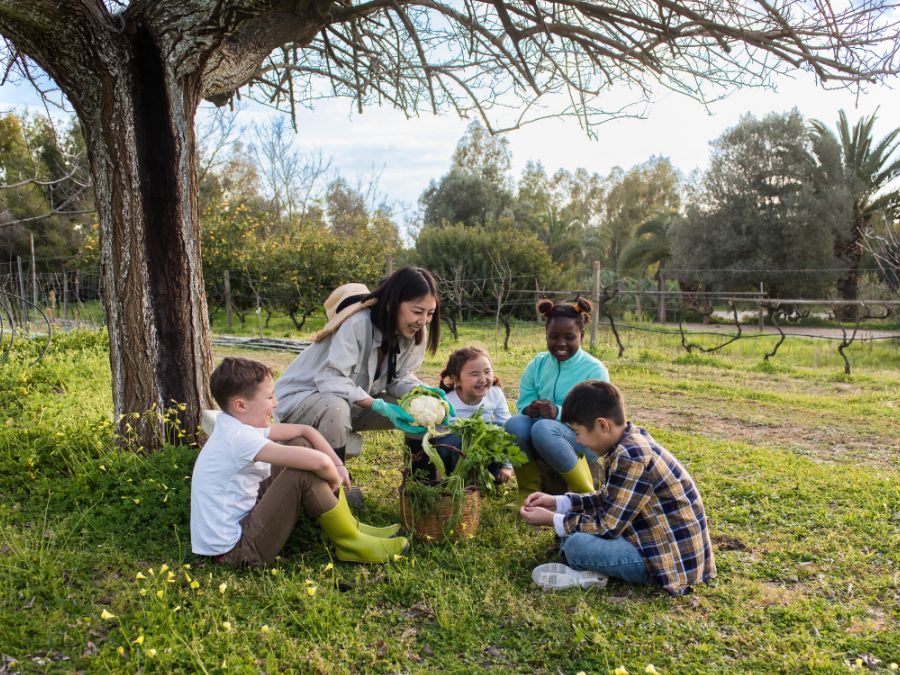
At the HOPE National Resource Center, one of our greatest joys is having opportunities to work with and learn from those engaged with HOPE—from workshop participants, advisors, and collaborators, to blog readers and commenters. This engagement and co-learning both spreads HOPE and improves our materials, resources, and core concepts.
In that spirit, we partnered with Corey Best (Community Curator, Mining for Gold, and HOPE National Advisory Board member) to solicit parent feedback on the HOPE website and Building Blocks. With his facilitation, we implemented an anonymous survey for the Birth Parent National Network (BPNN), “a national network of hundreds of birth parents and organizations working together to strengthen families, communities, and systems by engaging the voices of parents.” The aim of the survey was to garner input on whether various website pages and HOPE concepts were interesting and relevant to parents, whether concepts were inclusive of parents’ experiences, and whether parents found the Building Blocks practical to their own children’s lives. Ultimately, we received around 40 responses per question, with an overall positive response to HOPE’s strengths-based approach, inclusiveness, and relevance to respondents’ parenting. In this post, we present the aggregated results of this survey.
HOPE Home Page
Survey respondents were asked to scroll through the HOPE Home page (https://positiveexperience.org/) and indicate how much they agreed or disagreed with the following statements: “I want to learn more about HOPE”; “I feel that HOPE can help me parent my child”; “I feel that this page is inclusive of my community and my life experiences.”
Of the 41 responses, 85.4% agreed (i.e. reported “Strongly agree” or “Agree”) that they wanted to learn more about HOPE, 80.5% agreed that HOPE can help with their parenting, and 82.9% agreed that the home page was inclusive of their community and experiences (see Figure 1). Respondents were also given the opportunity to elaborate on their responses, and several commented favorably about the focus on positive experiences and resiliency. Respondents stated:
- “I like the ideas and the positive spin on experiences. I don’t like everyone always talking about negative things that hurt me and my children.”
- “Challenging life experiences as a child create our world view. Focusing on the positive resiliency in children and parents will help us shape our own outcomes mentally and spiritually in a positive light.”
- “Building on positive community experiences to foster the emotional development of young children into resilient adults is what we have all been waiting for in the world of child development. I do not find the ACES score to be a useful tool. All it tells me is that outcomes will be bad.”
- “I am excited to learn more about the approach and how I can use this model in my home and in my work as it aligns with the transformation of child welfare systems and trauma informed care.”
Several other comments expressed these same sentiments, that a focus on resiliency and the positive felt important for parenting, especially within a context of adversity.

The Building Blocks of HOPE
Respondents were directed to the HOPE About page (https://positiveexperience.org/about/) and asked to review the 4 Building Blocks of HOPE. After reviewing the page, respondents were asked how much they agreed or disagreed with the following statements: “I can think of realistic ways to strengthen this Building Block in my child’s life” (with one statement corresponding to each of the 4 Building Blocks—relationships, environments, engagement, and social emotional development). Respondents were also asked to indicate how much they agreed with the following statements about all 4 Building Blocks: “I feel the Building Blocks are a complete list of my priorities for my child”; “I think all 4 Building Blocks are important positive experiences for my child to have”; “In my community, all 4 Building Blocks are important positive experiences for children to have.”
With regard to thinking of realistic ways to strengthen Building Blocks in their children’s lives, most of the 40 respondents reported that they “Strongly agree” or “Agree” for each kind of positive childhood experience: relationships (80%), environments (82.5%), engagement (92.5%), and social emotional development (95%) (see Figure 2).

Most respondents also agreed that the Building Blocks are a complete list of their priorities (82.5%), that all four are important positive experiences for their child to have (92.5%), and that in their communities, all four are important positive experiences for children (90%) (see Figure 3). When asked to elaborate on their answers, many comments affirmed these overall results: “I didn’t put it into these exact words before like the Building Blocks are outlined, but I knew that these were the things that were my priorities”; “I agree with 4 Building Blocks based on my personal & professional experiences. I currently do not have any underage children but certainly have applied these building blocks into my own parenting based on my own childhood experiences”; “The building blocks are simple ideas that reduce stigma and build resiliency, stability and community. My children are grown but these building blocks are something that I can realistically use to strengthen my grandchildren’s lives.”

Areas for Improvement
Survey results overall indicated mostly positive responses to the HOPE Home page, About page, and Building Blocks. In answer to questions soliciting free-text comments and elaborations, however, some common suggestions emerged, pointing to areas of the website we can improve.
Regarding the Home page, two responses expressed a need for more parent-oriented examples, to concretely illustrate and clarify the HOPE approach for parents. One comment additionally suggested explicit language around cultural and socioeconomic diversity, stating, “…there should be a mention of Hope being an option for all cultures diversity and communities. As well as poverty stricken communities.”
In response to the Building Blocks and About page, other respondents shared similar concerns, stating that parents might not be able to use the Building Blocks without content that connects the concepts to things parents and families can do. Comments stated, “As a Parent Leader, I can see these things. If I were a new parent or a parent with recent experiences of being in a place of seeking resources, and/or lacking information, I would not have the ability to use the tool”; “Before going into the building blocks, I think there should be a mention that each block is inclusive of all family participation. Each block should have a little more description and an example.”
Conclusion
Overall, survey results indicate a largely positive response to the HOPE Home page, About page, and 4 Building Blocks. Upon reviewing these pages, most BPNN members felt interested in learning more about HOPE, felt that HOPE could help them parent, felt that they could think of ways to use the 4 Building Blocks in their parenting, and felt that all the Building Blocks were important for their children to have. In open-ended questions, several comments expressed an appreciation for HOPE’s focus on resiliency and positive experiences, especially in the face of adversity. Several comments also expressed that the Building Blocks articulated priorities respondents already held or practiced in their parenting.
In addition to this positive feedback, the HOPE team recognizes and appreciates the various points raised for website improvement. In response, we are working on developing additional descriptions and examples of the Building Blocks of HOPE. As indicated by respondents, it is critical that these examples are inclusive of diverse races, cultures, ethnicities, and socioeconomic statuses, to represent all the different ways HOPE and the 4 Building Blocks are adapted and used.
It is our hope that the website can provide resources that parents, families, and providers need to create positive childhood experiences. HOPE is always seeking to grow and improve, and thanks to Corey Best and the BPNN, we can build from these survey results—feedback that will shape the development of our future materials and core concepts. Powered by these improvements, HOPE will be able to support even more parents and providers, spreading positive experiences to children and families across the nation.
Thank you to Corey Best and the BPNN for this fruitful collaboration, and thank you to every respondent who took the time to complete this survey. This survey was designed and implemented by Chloe Yang, with design support from Drs. Dina Burstein and Robert Sege.
Photo in graphic by Mike Scheid on Unsplash


